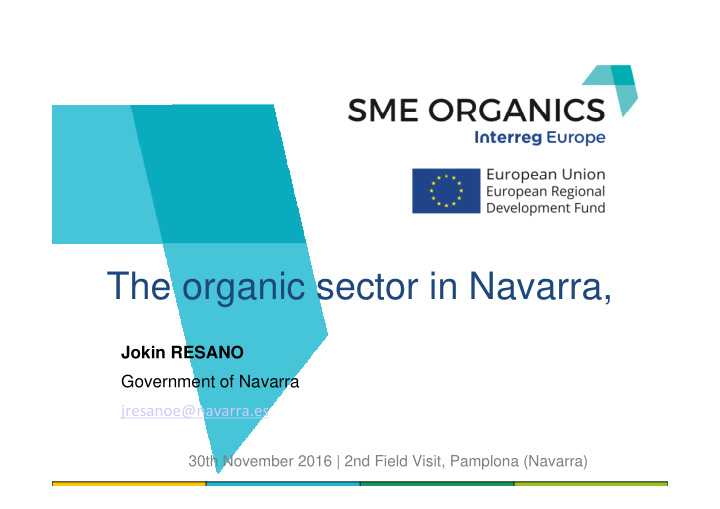



The organic sector in Navarra, Jokin RESANO Government of Navarra jresanoe@navarra.es 30th November 2016 | 2nd Field Visit, Pamplona (Navarra)
NAVARRA REGION – Basic facts • Location: North of the Iberian Peninsula • Extension: 10.391,08 km2. • Population: 640.339 inhabitants (307.000 in 1900); 61 inhabitants per km2 (29 in 1900). • GDP per capita: 30.800 € (126,7% of the average of Spain and 125.7% of the European average)
NAVARRA REGION – Topography and climatic conditions Several climatic areas: Atlantic, Mediterranean Continental and combinations of their influences as Sub- Mediterranean, Sub-Atlantic and Sub-Alpine. Topography: mountains in the north and flatland in the south This confluence leads to a diversity of farms by generating a wide variety of agricultural productions.
NAVARRA REGION – Primary production • Agricultural surface: 545.520 ha • 224.690 ha pastures (41,19%) • 287.720 ha of arable land (52,75%) 33.060 ha permanent crops (6,06%)( data Eurostat 2010 ) • • Extensive livestock (42,09%), mixed farms adapted to the environment, intensive livestock (57,91%) • Forests and forest lands, 594.357 ha (57,19% of the regional) • Agroindustry, meat industry, bakery and pastries, fruit and vegetables and drinks (juices, wine and olive oil)
ORGANIC SECTOR- Absolute production data Main productions and uses in terms of • Representative of surface (ha) agricultural land production: Pasture and forest land 36.431 Arable land 9.900 Vineyard 985 Olive trees 543 Almond trees 210 Other fruit trees 151
ORGANIC SECTOR - Relative production data • Olive the crop with more organic % Organic area with respect to the total agricultural area area compared to the total of its production in Navarre Olive trees 8,49 • Production of cereal, legumes and fodder, strong presence of Almond trees 6,47 fallow within the rotations, related to arid or semi-arid Vineyard 5,22 drylands (non irrigated areas) Pasture and forest land 5,71 • Horticultural production. Producers often unrelated to Other fruit trees, asparagus and 3-5 agri-food industry. Production for arable land short food supply chains.
ORGANIC SECTOR - Trends • Food industry • Frequently supplied with primary production outside of Navarre: wineries, olive oil presses, canneries, bakery and confectionery industries. Juices, coffee, infusions, sausages, meats, canned fish, honey, beer, prepared products and other food products. • 128 companies. • Continous growing, an indicator of the upward trend in production and consumption organic products. • Points of sale , increase in the last years of members in consumers associations of organic products, specialized stores and the space dedicated to these products in supermarkets.
PUBLIC SUPPORT TO OFF: TRAINING AND ADVICE TO FARMERS • Working groups in order to consider the organic producer sector, their demands and proposals for the advice and experimentation programme • Organized by productive sub-sectors: • Horticultural outdoor and indoor production • Fruits • Cereals and legumes and seed producing entities • Vine and nursery • Entities producing vegetable propagating material, potato and artichoke • Olive • Participation of the Agricultural Service of the Government of Navarra, the technicians responsible for the experimentation in organic production of INTIA and some relevant farmers of each subsector.
PUBLIC SUPPORT TO OFF: TRAINING AND ADVICE TO FARMERS SOME CONCLUSIONS FROM THE WORKING GROUPS: - Problematic supply of horticultural seed with commercial characteristics market demand - Lack of advice, experimentation and transmission technical information. Integral experimentation - Problematic cereal seed, certified and “maquila” - Need for coordinating actions, eg, producer- agribusiness, cereal-livestoc
PUBLIC SUPPORT MEASURES Instrument Mesure Responsible Beneficiary Finantial Contribution European Agricultural Guarantee Fund Greening DRMAyAL Farmers (EAGF) EAGF Fruit and Veg Operational Programs DRMAyAL Producer org 4,1% Value product marketed, 50% investment EAGF Program Fruit and veg at schools DRMAyAL Distributors 20% OP European Agricultural Fund for Rural OP Conversion and maintenance DRMAyAL Farmers Max 600-900€/Ha Development (EAFRD) EAFRD Investment in agricultural farms DRMAyAL Farmers 5 points more EAFRD Installation of young farmers DRMAyAL Farmers 15 points more European Regional Development Fund R&D Economic Developmment Companies, (ERDF) R&D center ERDF SME Competitiviness Economic Developmment Companies
ARE THE EXISTING DISTRIBUTION AND COMMERCIALIZATION STRUCTURES VALID ON ORGANIC PRODUCTION? Plurality of organic productions and structural plurality of production and processing farms, also reflected in the commercialization, with organic product exporting companies beyond EU borders and family structure companies that transform their own production and market 100% through short food supply chains
ARE THE EXISTING DISTRIBUTION AND COMMERCIALIZATION STRUCTURES VALID ON ORGANIC PRODUCTION? Four different productive situations: • Primary producers of small productions, mainly fresh vegetables, production through short food supply chains, direct relationship between producer and consumer • Primary producers of highly specialized productions not short channels, lack of storage and conservation infrastructures,channeled through producer associations or through wholesalers (normally export) • Conventional food agro-industry (large companies) need of regular, specialized and large-scale primary production, difficult for the organic primary producer • Food agro-industry producing organic but non-perishable products (usually oil and wine), local markets and export
Thank you! Project Questions welcome smedia
Recommend
More recommend